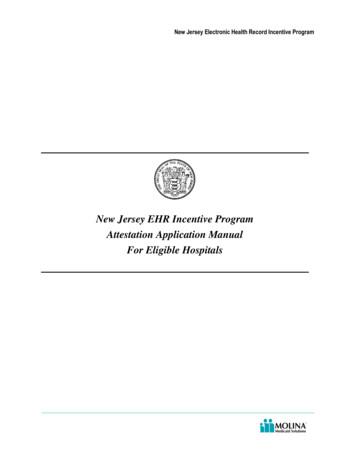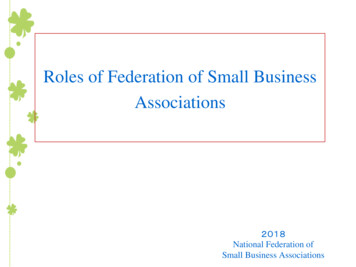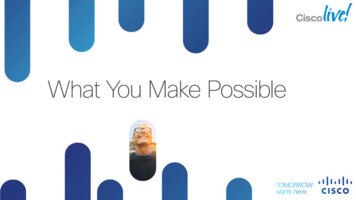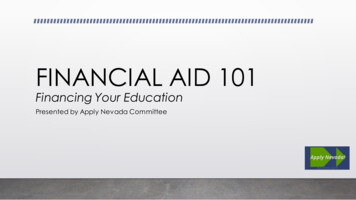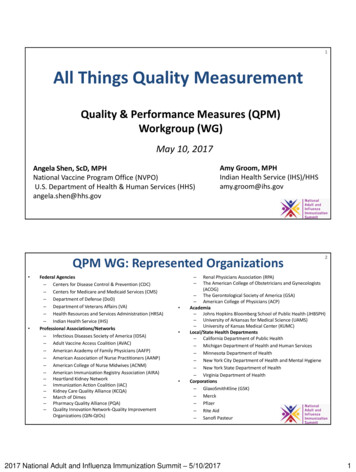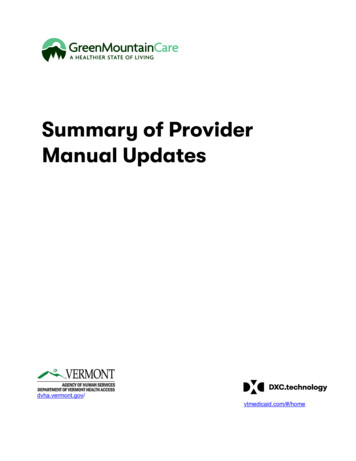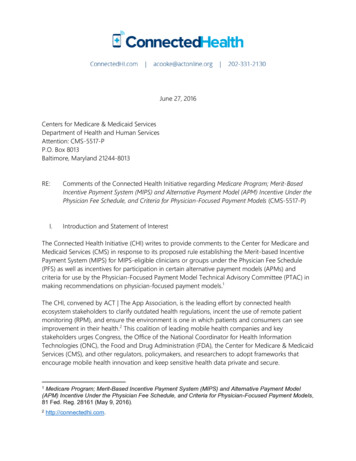
Transcription
Incentive FederationProgram Design & Support: End-User SurveyJanuary 2015
2Background & Methodology The Incentive Federation engaged Intellective Group to conduct a study with a nationalsample of business stakeholders to understand design considerations and supportmechanisms for reward and recognition programs. The audience was reward and recognition “end-users” in firms with at least 1 million inannual revenue. To qualify, respondents must have some level of responsibility for non-cash programs fortheir salespeople, for channel/dealer partners, or for their employees. For the purposes of this study, channel and dealer partners are defined as thedistribution channel of the end-user company. A panel was utilized for business decision-maker sample, providing several benefits: 1)participants opt-in to receive relevant surveys; 2) surveys are disseminated in a highlytargeted manner to participants likely to qualify to complete them; and 3) participantsare incented by the panel they are part of. A fifteen-minute online survey was distributed. Data collection took place betweenDecember 29, 2014 and January 2, 2015.
3Number of Respondents by Firm Size A total of 234 business people with responsibilities related to reward and recognitionprograms responded to the survey*. This sample size results in a 95% confidence level and a6.4% margin of error. (If the study was repeated 100 times, 95% of the studies wouldgenerate results with 6.4% of the current study.) To ensure representation across firm size, quotas were used to control the number ofrespondents by size of company, as shown in the table below.Firm Size(by Revenue)Number of RespondentsPercent of Respondents 1 million to 9.9 million5122% 10 million to 99 million5021% 100 million to 999 million6628% 1 billion or more6729%*Sales n 104, Channel n 45, Employee n 159
4Weighting Because the study objective is to project findings to the population of U.S. businesses, allfindings are statistically weighted to reflect the highly-skewed distribution of firms; for everyfirm over 1 billion in revenues, there are 472 firms between 1 and 10 million in annualrevenues. One effect of this skewed distribution is that any activity common but unique to the largestcompanies will actually be very rare in the overall population. For example, if only thosecompanies over 100 million in annual revenue could own private jets, at most 1.2% of USbusinesses would have a jet - if every firm of that size had one.Company Revenue 1 to 10 million 10 to 100 million 100 million to 1 billionOver 1 billionTotalsNumber of US nt of All Companies Over 1Million in Revenue86%12%1%0.2%As company size increases, so do divisions, locations, and decision-makers. It is unlikely any individual survey respondent within a largefirm is able to provide information wider than their own division. A marketing respondent is able to provide insights about thatdepartment’s reward/recognition, but not for other departments like sales, HR, etc. Therefore, activities reported here for the largestfirms are likely conservative.
5Leveraging Study Findings This deck is a compilation of results across a wide range of topics relative to how reward andrecognition programs are designed and operated across US businesses. The depth and breadth of information produced by this study lends itself to a number oftopical publications, such as: Individual primers for program managers of: Sales programs Channel programs Employee programs Individual reviews of reward and recognition programs for firms with: 1-9 million in annual revenue 10 – 99 million in annual revenue 100 - 999 million in annual revenue 1 billion or more in annual revenue A review of program design considerations for reward and recognition end-users A review of program support mechanics found in reward and recognition programs Gaps in end-user awareness or capability to be addressed by the incentives industry
6Queuing Up “Reward and Recognition” for Respondents.As a topic, “reward and recognition” was broadly outlined to respondents, as follows: “Many companies work to recognize and reward stakeholder groups to desired behaviors.For example, a company may offer incentives to their sales teams that go beyond theircompensation, offer partners perks to recommend or sell their products over those ofcompetitors, or recognize employees for years of service. Additionally, some companiesprovide incentives to all employees to reach performance or other types of goals (safety,wellness). These are the types of non cash-related activities we’d like to learn about for yourcompany.”
7Program Design
8Program Connectivity by AudienceCompanies are frequently running multiple Sales and Channel programs that are connected through an“umbrella” program – a unifying theme or focus. In contrast, while companies are also running multipleEmployee programs during the year, not all are typically connected under one over-arching program.Programs Per Year By AudienceWe run one reward program per yearWe run multiple programs in a year, but they are all connected to an umbrella programWe run multiple discrete programs per yearWe run multiple programs in a year: some are connected and some are discrete45%41%43%29%26%18%16%SALESn 23414%20%12%CHAN N E L24%13%E M P LOY E E
9Pace of Programs by AudienceChannel programs are often paced such that some programs are offered every year, with additional programsadded on during the year to address specific goals. Half of Sales programs follow this pace as well. Employeeprograms take many forms; some firms have yearly programs while others launch programs as needed.Program Cadence By AudienceWe offer our program(s) every yearWe offer some program(s) every year, and others are launched as we have specific goals to meetWe launch our programs only as we have specific goals to meet67%50%40%38%34%26%22%12%SALESn 23412%CHAN N E LE M P LOY E E
10Sales Program ObjectivesIntuitively, the most common objective of Sales programs is to increase overall sales. Increasing the morale ofthe salesforce is a close second.Program Objectives: SalesIncrease overall sales80%Improve morale76%Improve productivity58%Improve customer satisfaction52%Gain market share47%Increase sales of specific product(s) or service(s)Change culturen 10427%21%Promote cost reduction17%Reward completion of training16%
11Channel Program ObjectivesProductivity gains are the most important objective to firms operating Channel programs – nearly all companiesindicate this is a priority. Intuitively, sales-specific goals, such as product sales and market share gains, are alsoof considerable importance to these programs.Program Objectives: ChannelImprove productivity97%Increase sales of specific product(s) or service(s)63%Increase overall sales62%Gain market share59%Gain share of mind for non-exclusive sales channelReward completion of trainingn 4540%19%
12Employee Program ObjectivesMost firms operate Employee programs with the objective of improving morale. Other common goals areimproving productivity, improving customer satisfaction, and recognizing years of service.Program Objectives: EmployeeImprove morale84%Improve productivity58%Improve customer satisfaction48%Recognize years of service41%Promote innovation28%Increase sales of specific product(s) or service(s)27%Promote wellness23%Change culture19%Reduce waste15%Promote safetyReward completion of trainingPromote cost reductionPromote other specific behaviors or goals (please specify)n 15914%9%8%6%
13Program StructuresThe pages that follow outline the structures for Sales, Channel, and Employee programs. Structures weredescribed for respondents as below:SalesChannelEmployeeSales quotaParticipants receive individualizedquota targets and earn rewardsupon hitting those targets.Participants receive individualizedquota targets and earn rewards uponhitting those targets.n/aOther types ofgoal-basedearningParticipants receive individualizedgoal targets and earn rewardsupon reaching those goals (newproduct or other training, clearinginventory, etc.).Participants receive individualized goaltargets and earn rewards uponreaching those goals.Participants receive individualized goaltargets and earn rewards upon reachingthose goals.Top performerGoals are set among allparticipants and the topperformer(s) earn rewards at theend of a set time period for theprogram.Goals are set among all participantsand the top performer(s) earn rewardsat the end of a set time period for theprogram.Goals are set among all participants and thetop performer(s) earn rewards at the end ofa set time period for the program.DiscretionaryrecognitionRecognition or award is given on aspot basis, e.g., a manager to anemployee, peer to peer amongemployees.Recognition or award is given on a spotbasis, e.g., a company rep to a channelpartner.Recognition or award is given on a spotbasis, e.g., a manager to an employee, peerto peer among employees.TeamrecognitionRecognition or award is given to ateam for group achievements orfor reaching team goals.Recognition or award is given to a teamfor group achievements or for reachingteam goals.Recognition or award is given to a team forgroup achievements or for reaching /an/aRecognition or award is given uponattainment of service anniversary or othermilestone (e.g., patent awards or Six Sigmacertification).
14Sales Program StructureCompanies use a broad range of rule structures when designing Sales programs, but the most commonstructures are based on sales quotas.Sales Program StructureSales quota62%Other types of goal-based earningDiscretionary recognitionTop performerTeam recognitionn 10446%40%39%37%
15Channel Program StructureSimilar to Sales programs, companies employ a wide range of rule structures for Channel programs, with themost prevalent being sales quotas.Channel Program StructureSales quota77%Discretionary recognition65%Top performer52%Other types of goal-based earningTeam recognitionn 4541%36%
16Employee Program StructureDiscretionary recognition is the most common Employee program, but team recognition, serviceanniversary/milestone, and goal-based earning are also well-utilized rule structures.Employee Program StructureDiscretionary recognition70%Team recognition53%Service anniversary/milestone47%Goal-based earningTop performern 15942%21%
17Sales Program Evaluation MetricsWhen evaluating the success of Sales programs, most companies use product sales (in dollars) to measurereturn. Another popular metric for Sales programs is net-new customers. ROI calculations are only used in 20%of programs.Sales Program MetricsProduct sales - dollars66%Net new customers49%Product sales - units37%Other financial metrics (such as overall revenue)36%Productivity metrics (sales processes, etc.)25%Staying within budget24%Return-on-investment20%Employee tenure20%Attitudinal - satisfaction surveysOther (please specify)n 10414%1%
18Channel Program Evaluation MetricsCompared to Sales programs, Channel programs place a higher emphasis on net-new customers as aperformance outcome. Product sales (in dollars) is also a top evaluation metric for Channel.Channel Program MetricsNet new customers75%Product sales - dollars70%Product sales - units49%Market share49%Attitudinal - satisfaction surveys28%Brand compliances27%Product knowledgeOther (please specify)n 4522% 1%
19Employee Program Evaluation MetricsProductivity is the most common performance measure for Employee programs, followed by employee tenureand employee satisfaction.Employee Program MetricsProductivity metrics (sales processes, etc.)Employee tenure49%Attitudinal - satisfaction surveys49%Other (please specify)n 15973%6%
20Priorities When Designing Sales ProgramsThe most important design consideration for Sales program managers is ensuring that the program rewards theright people. This is seen as a more critical consideration than organizational alignment, establishing a culture ofrecognition, and other factors that pertain to participant engagement. It’s likely that if this criteria is not met bythe program, everything else suffers as well.Design Considerations: Sales ProgramsPointsIt truly rewards the right people20It aligns with organizational mission14It makes recognition part of day-to-day activities12Participants can choose their own awards10Many participants receive an award10Is it fresh and interesting to participants10It integrates with other organizational systemsIt is tailored and specific to an audience6It is also a training tool6Your company can leverage bulk purchase of award itemsn 10474Respondents were asked to allocate100 points across variousconsiderations that impact programdesign. Items that are higher priorityhave more points assigned to them.This method allows for ratiocomparisons – an item with 20points is twice as important as anitem with 10 points.
21Priorities When Designing Channel ProgramsDesign considerations for Channel programs are less differentiated in terms of importance. Rewarding the rightpeople is a top concern, but is tied with organizational alignment for first place. Tailoring the program to theaudience is of greater interest here than in Sales programs.Design Considerations: Channel ProgramsPointsIt truly rewards the right people15It aligns with organizational mission15It is tailored and specific to an audience13Is it fresh and interesting to participants12It integrates with other organizational systems11Many participants receive an awardParticipants can choose their own awards7It is also a training tool7It makes recognition part of day-to-day activitiesYour company can leverage bulk purchase of award itemsn 451065Respondents were asked to allocate100 points across variousconsiderations that impact programdesign. Items that are higher priorityhave more points assigned to them.This method allows for ratiocomparisons – an item with 20points is twice as important as anitem with 10 points.
22Priorities When Designing Employee ProgramsBy far, the most important design consideration for Employee programs is ensuring that the program rewardsthe right people. The second-most-important priority for these programs is making recognition a part of day-today activities.Design Considerations: Employee ProgramsPointsIt truly rewards the right people26It makes recognition part of day-to-day activities18It aligns with organizational mission10Is it fresh and interesting to participants9Many participants receive an awardParticipants can choose their own awards6It is tailored and specific to an audience6It integrates with other organizational systems6It is also a training tool5Your company can leverage bulk purchase of award itemsn 15995Respondents were asked to allocate100 points across variousconsiderations that impact programdesign. Items that are higher priorityhave more points assigned to them.This method allows for ratiocomparisons – an item with 20points is twice as important as anitem with 10 points.
23Program Spend
24Program Spend by AudienceThe typical company spends less than 50,000 per year on their program(s), regardless of the program audience.This is due to the vast number of small businesses in relation to larger firms.Program Spend By AudienceLess than 50,000 50,000 to 99,999 100,000 to 249,999 250,000 to 499,999 500,000 or more67%61%48%35%24%8%SALESn 23417%12%5%1%10%3%CHAN N E L1%3%E M P LOY E E3%
25Sales Program Spend by Firm RevenueSmaller firms most frequently report spending less than 50,000 per year on Sales programs. More robustinvestment in Sales programs can be seen once firms pass the 10M revenue mark, and increases are apparentas company size grows. It is possible that total spend on Sales programs was not captured in the largest of firms,due to distributed spend across numerous divisions and operating units.Program Spend By Company Revenue: SalesLess than 50,000 50,000 to 99,999 100,000 to 249,999 250,000 to 499,999 500,000 or more67%38%31%25%24%4% 4% 1 TO 9 .9n 10419%19%14%13% 13%26%26%25%15%15%19%5% 1% 1 0 TO 9 9 1 0 0 TO 9 9 9(in millions) 1000
26Channel Program Spend by Firm RevenueHalf of smaller firms report spending less than 50,000 per year on Channel programs. Investment in Channelprograms increases as firms pass the 10M revenue mark, and continues to increase as company size grows. It ispossible that total spend on Channel programs was not captured in the largest of firms, due to distributed spendacross numerous divisions and operating units.Program Spend By Company Revenue: ChannelLess than 50,000 50,000 to 99,999 100,000 to 249,999 250,000 to 499,999 500,000 or more60%50%40%41%38%25% 25%25%20%13%10%7% 7% 1% 1%n 45 1 TO 9 .9 1%17% 17%9% 1% 1 0 TO 9 9 1 0 0 TO 9 9 9(in millions) 1000
27Employee Program Spend by Firm RevenueThe majority of small firms spend less than 50,000 per year on Employee programs, and this level of spendingis also seen among a considerable proportion of larger firms. Within the largest companies, spending onEmployee programs increases dramatically. It is possible that total spend on Employee programs was notcaptured in the largest of firms, due to distributed spend across numerous divisions and operating units.Program Spend By Company Revenue: EmployeeLess than 50,000 50,000 to 99,999 100,000 to 249,999 250,000 to 499,999 500,000 or more70%50%32%30%29%23%18%15%14% 16% 16%20%9%9%3% 3% 1 TO 9.9n 15921%16%3% 1% 10 TO 99 100 TO 999(in millions) 1000
28Total Spend (Cross-Audience Spend) by Firm SizeMany companies operate programs across multiple audiences. When combining the budgets across programs(for example, Sales and Employee program spend), the relationship between reward and recognition spend andcompany size becomes even more apparent.Total Spend (In Thousands) By Company Revenue 50 50-99 100 76%59%45%44%40%31%24%24%19%17%16%4% 1 TO 9.9n 234 10 TO 99 100 TO 999(in millions) 1000
29Program Rewards & Recognition
30Program Rewards and RecognitionThe pages that follow outline reward and recognition provided for sales, channel, and employee programs.These were described for respondents as below: *SalesChannelEmployeeRecognitionawardsPerks to recognize participantssuch as time off from work,parking spots, free lunches.Little perks or “thank you’s” torecognize channel/dealer personnel.Perks to recognize participants such as timeoff from work, parking spots, free lunches.RecognitioneventsGatherings or awards to recognizeparticipants such as recognitionceremonies/meetings orrecognition awards (e.g.,Employee of the Month, etc.)Gatherings or awards to recognizeparticipants such as recognitionceremonies/meetings or recognitionawards (e.g., brand compliance, etc.)Gatherings or awards to recognizeparticipants such as recognitionceremonies/meetings or recognition awards(e.g., Employee of the Month, etc.)SymbolicawardsE.g., plaques, trophiesE.g., plaques, trophiesE.g., plaques, trophiesMerchandiseawardsMerchandise or other awardsused as part of an incentive orrecognition program. Rewardsmay be a variety of products ofdiffering values.Merchandise or other awards used aspart of an incentive or recognitionprogram. Rewards may be a variety ofproducts of differing values.Merchandise or other awards used as partof an incentive or recognition program.Rewards may be a variety of products ofdiffering values.Groupincentive tripsGroup travel experiences . travelis the key award. Participants maywin a spot on a group travelprogram, or they may be able toselect from among various travelpackages – either group or relatedexpenses including room andother gifts included.Group travel experiences . travel is thekey award. Participants may win a spoton a group travel program, or they maybe able to select from among varioustravel packages – either group orrelated expenses including room andother gifts included.Group travel experiences . travel is the keyaward. Participants may win a spot on agroup travel program, or they may be ableto select from among various travelpackages – either group or related expensesincluding room and other gifts included.*Logo’d merchandise, gift cards/gift certificates, and individual travel were presented without explanatory context.
31Types of Recognition/Rewards by AudienceRecognition awards, recognition events, and gift cards are the most common types of recognition/rewardutilized, regardless of program audience. Excepting the absence of group incentive travel within Employeeprograms, the various recognition and reward types are represented in all program types.Recognition/Reward Type By AudienceRecognition awardsRecognition eventsLogo'd merchandiseSymbolic awardsGift cards/gift certificatesMerchandise awardsIndividual travelGroup incentive 24%21%29%28%18%32%16%16%1%SALESn 234CHAN N E LE M P LOY E E
32Incidence of Points-based Programs by Award TypeFor programs offering merchandise or individual travel awards, points-based systems of earning and redemptionare used to varying degrees, depending on audience type. Channel programs have a very high incidence ofpoints programs for both merchandise and individual travel, while points are more common for merchandisebased Sales programs than those including individual travel. Points are not common within Employee programs.Points-based Award ProgramsMerchandise awardsIndividual travel95%76%58%18%SALES14%CHAN N E L16%E M P LOY E E
33Types of Merchandise Used in Sales ProgramsThree merchandise categories dominate in terms of prevalence in Sales programs: food and beverages,electronics, and apparel. The remaining categories of merchandise are not negligible – the least-frequentcategories are found in one out of five programs.Merchandise Prevalence in Sales ProgramsFood and beverages80%Electronic items76%Apparel74%Home improvement items/tools39%Jewelry/accessories37%Writing instruments35%Housewares34%Sporting/recreational goods24%Watches/clocks22%Luggage21%Home décorOthern 3919%5%
34Types of Merchandise Used in Channel ProgramsFood and beverages are ubiquitous within Channel programs, while electronics and writing instruments alsomake a strong showing. Housewares are absent within Channel programs.Merchandise Prevalence in Channel ProgramsFood and beverages100%Electronic items68%Apparel33%Home improvement items/tools32%Jewelry/accessories31%Writing instrumentsHousewares63% 1%Sporting/recreational goods32%Watches/clocks32%Luggage32%Home décor32%Othern 15 1%
35Types of Merchandise Used in Employee ProgramsElectronics take the top spot in Employee programs, followed by food and beverages and apparel. Sportinggoods, luggage, watches and clocks, and home décor are other categories favored for Employee programs.Merchandise Prevalence in Employee ProgramsFood and beverages63%Electronic items76%ApparelHome improvement items/tools59%9%Jewelry/accessoriesWriting instrumentsHousewares11%7%6%Sporting/recreational goods46%Watches/clocks33%Luggage39%Home décorOthern 6222%7%
36Incidence of Cash as Non-Compensation RewardWhen asked if their non-compensation reward mix includes cash, a large percentage of companies responded inthe affirmative. However, when asked to describe these cash rewards, many program managers mentionbonuses and gift cards. The implications are twofold: there is not a commonly-understood line betweencompensation and rewards, and gift cards are considered cash-like to some program managers.Reward Mix: Cash Included71%66%61%SALESn 234CHAN N E L/ D EALE RE M P LOY E E
37Reward and Recognition Preference by Program Rule Structure In terms of the application of specific types of reward and recognition, buyerswere asked about various program rule structures and the types of reward andrecognition they prefer in each of these circumstances. Some reward andrecognition types are preferred more or less than others depending on programs.The broader learning, however, is that all types of rewards and recognition areused to reward participants for all types of programs.
38Preferred Reward/Recognition by Program Structure: SalesExample for interpreting thisinformation: Among those with sales quotaprograms, 9% prefer merchandiseawards.Sales Quota(n 67)Other GoalBased Earning(n 50)TopPerformer(n 43)DiscretionaryTeam (n 41)(n 44)Merchandise (awards)9%17%11%2%13%Merchandise (logo’d)19%17%12%29%19%Merchandise (symbolic)7%8%24%12%10%Gift cards/gift certificates52%46%59%85%10%Individual travel13%8%21%46%19%Group travel18%8%1%--31%Recognition awards38%17%55%38%32%Recognition events12%11%40%19%33%
39Preferred Reward/Recognition by Program Structure: ChannelExample for interpreting thisinformation: Among those with sales quotaprograms, 23% prefer merchandiseawards.Sales Quota(n 35)Merchandise (awards)23%23%18%28%25%Merchandise (logo’d)26%23%8%32%50%Merchandise (symbolic)23%22%35%27%50%Gift cards/gift certificates36%25%55%42%1%Individual travel11%22%55%29%25%Group travel11%22%18%14%25%Recognition awards39%45%38%2%50%Recognition events34%29%38%41%25%Other GoalBased Earning(n 18)TopPerformer(n 23)DiscretionaryTeam (n 16)(n 29)
40Preferred Reward/Recognition by Program Structure: EmployeeExample for interpreting thisinformation: Among those with serviceanniversary programs, 10% prefermerchandise awards.Service Anniv. Goal-BasedEarning (n 65)(n 71)TopPerformer(n 33)DiscretionaryTeam (n 81)(n 107)Merchandise (awards)10%6%3%13%14%Merchandise (logo’d)4%7%2%22%14%Merchandise (symbolic)26%27%4%4%7%Gift cards/gift certificates28%49%61%72%52%Individual travel6%12%--8%15%Group travel--1%2%--1%Recognition awards32%23%15%37%15%Recognition events36%4%42%23%28%
41Use of Suppliers
42Use of Suppliers By Program TypeAs expected, the highest use of suppliers is for sourcing of merchandise, gift cards, and travel rewards. For nonreward support, Channel has the highest incidence of relying on suppliers for expertise, design, and programadministration, while Employee programs show the lowest incidence of using outside support for theseactivities.Use of 2%SalesChannel/Dealer31%EmployeeWe work with suppliers (including local retailers) to provide the merchandise and/or gift card rewards for ourprogram(s).We work with suppliers to provide the travel rewards for our program(s).We work with suppliers to design our program(s).We work with suppliers to track and communicate our program(s).We look to suppliers for expertise relative to the best ways to recognize and incent our participants.n 234
43Engagement of Suppliers by Program TypeMultiple suppliers are often used to support Sales and Employee programs. Conversely, nearly half of Channelprograms are supported by a single supplier.Supplier Engagement By Program TypeWe typically work with a single suppler.We typically work with multiple suppliers.69%62%54%46%38%31%SALESn 234CHAN N E LE M P LOY E E
44Use of Suppliers for Sales Programs by Firm SizeFor Sales programs, larger companies use multiple suppliers more often than the smallest companies do. Only aquarter of larger firms use a single supplier for program support.Sales Program Supplier Engagement By Company RevenueWe typically work with a single suppler.We typically work with multiple suppliers.77%77%75%60%40%25% 1 TO 9 .9n 10423% 1 0 TO 9 9 1 0 0 TO 9 9 9(in millions)23% 1000
45Use of Suppliers for Channel Programs By Firm SizeSimilar to Sales programs, Channel programs in large firms show a higher incidence of multiple suppliers than dosmall companies.Channel Program Supplier Engagement By Company RevenueWe typically work with a single suppler.We typically work with multiple suppliers.92%86%64%50%50%36%14%8% 1 TO 9 .9n 45 1 0 TO 9 9 1 0 0 TO 9 9 9(in millions) 1000
46Use of Suppliers for Employee Programs by Firm SizeUnlike Sales and Channel programs, Employee programs show a consistently high incidence of multiple suppliersacross all company sizes. For all firm size categories, only a quarter to a third of companies use a single supplier.Employee Program Supplier Engagement By Company RevenueWe typically work with a single suppler.We typically work with multiple suppliers.75%74%68%67%33%32%26%25% 1 TO 9 .9n 159 1 0 TO 9 9 1 0 0 TO 9 9 9(in millions) 1000
47Types of Suppliers Engaged by Program TypeFor Sales program support, there is a strong presence of full-service reward and recognition providers, gift cardproviders, and merchandise providers. Within Channel programs there is a strong reliance on merchandisereward providers and, to a lesser extent, gift card suppliers. The opposite is seen in Employee programs, wheregift card suppliers have the highest incidence followed by merchandise providers.Types Of Suppliers UsedFull-service reward and recognition suppliersFull-service advertising agenciesFull-service travel providersMerchandise reward providersGift card providersTravel providers: specific servicesOther75%71%58%55%51%43% 41% 42%43%26% 26%45%40%25%23%14%4%n 234SALES 1%CHAN N E L16%7%6%E M P LOY E E
48Sourcing for Merchandise and Gift CardsAmong companies using merchandise or gift cards for their programs, a majority source those rewards fromlocal retailers. The next most-prevalent source is incentives-industry companies, followed by the corporate B2Bsales team for retailers or merchandisers.Merchandise And Gift Card SourcingWe get rewards from local retailer locations57%We get our rewards from a company that specializes in sellingrewards/merchandise or an incentive/promotional agency.41%We work with the corporate offices of a retailer to purchaserewards/merchandise23%OtherI don't known 1648%3%
49Sourcing of Merchandise and Gift Cards by Firm SizeThe reliance on local retailers for merchandise and gift cards is highest a
mechanisms for reward and recognition programs. The audience was reward and recognition "end-users" in firms with at least 1 million in annual revenue. . Employee programs during the year, not all are typically connected under one over-arching program. 8 n 234 . Pace of Programs by Audience 38% 12% 40% 50% 67% 34% 12% 22%
